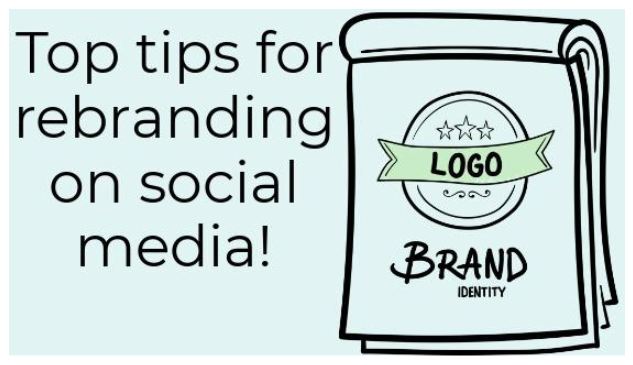How to Effectively Execute a Rebrand on Social Media
The average consumer is exposed to 10,000 brand messages per day.
Quick Links
The sheer number of advertisements and brand visuals being broadcast makes it difficult for businesses to remain competitive— resulting in entrepreneurs all asking the same question: “How do we break through the noise?”.
Unfortunately, there is no simple answer or quick fix.
Instead, there are proven methods that can help businesses re-establish a higher position within their market and strengthen customer loyalty. The catch? They require time, focus, and in most cases, financial investment.
Rebranding is one of these solutions.
How to know when it’s time to rebrand
In an ideal world, businesses would be able to create a visual identity for their business and use it forever. It would definitely save companies a ton of money and brainpower.
But realistically, this just isn’t possible. As new generations gain buying power, what is expected of businesses begins to shift and what was traditionally effective advertising starts to lose its lustre.
So, how can business owners remain ahead of the curve and recognize when the time for change has come?

Image Source: Design Wizard
Here are a few signs that your branding may be due for a revamp:
- Your services or products have expanded. Since you first created your brand identity your messages, visuals, or brand narratives are no longer reflective of your brand. You need something to showcase the full extent of what you have to offer.
- Your business has taken on a new brand vision. Your current branding reflects where you have been, but not where you want to go. With new plans must come a new strategy.
- Your branding doesn’t celebrate what makes your brand unique. It does little to deviate you from your competitors. In this highly busy world, you need to differentiate yourself from the crowd.
- Your company is collaborating with another business. If your company is taking on a major project with another organisation, then you need to make some changes. You need to communicate in a fresh, new and exciting way.
- Your target audience has evolved or expanded. The most important element in the business mix. If you’re including new demographics, then you need to appeal to your audience members.
The essential steps for a successful rebrand
You will only get out of your rebranding strategy what you put into it. Thus, it’s imperative that business owners approach every stage of the rebranding process with an open (yet highly critical) mind.
Every aspect of your company’s identity will need to be examined. From Instagram accounts, logos, and websites. All the way down to your mission statement, advertising campaigns, and approach to customer service.
Too often, businesses bite off more than they can chew and struggle to prioritise the changes that need to be made.
To make things easier, we’ve put together a step-by-step guide.

Image Source: Design Wizard
Here are several vital steps every successful rebranding should include:
1 DELVE INTO THE DATA
Gathering up all the numbers, stats, and metrics of your business can be laborious work. But your rebranding strategy will be better for it in the end. The more data-driven your strategy is, the more you can avoid potential mishaps and better predict outcomes.
We specifically recommend taking a look at your brand mentions, media mentions, brand searches, and your net promoter score. These metrics can help you gain a thorough understanding of what people are saying about your business, what aspects of your brand they appreciate the most, and what motivates them to purchase.
2 FIND YOUR NICHE
Each time a company rebrands, it’s crucial to re-examine the playing field. What are your competitors already doing? Are there gaps in the market that aren’t being filled by other businesses in your space? How can you set yourself apart from your adversaries without deterring your target audience?
All of these questions will need to be answered. Your rebranding strategy needs to be deliberate and calculated. Thus, the more you know about the overall landscape of the market you are in, the more you can position your branding meaningfully.
3 GET CREATIVE
Once all required research has been completed, the fun part begins. This is when you will begin brainstorming your new visual identity and key messaging.
Whether it’s designing stunning social media graphics, improving the functionality of your website, or developing a fresh new logo, this is when all of the elements of your brand that customers interact with will be considered.
Creating an updated brand style guide is always a great place to start.
We recommend checking out this post from Hubspot for inspiration.
When you are satisfied with your brand style guide, you can then use this document to inform the overall aesthetics of your various platforms, including your website, social media profiles, print materials, and more.

4 Identify your key locations
Your customers and potential customers should be the main reason for rebranding on social media. After all without them your business would not have any grounds for staying open.
Using the social platforms where your audience is will give you the boost you need. If all your audience is on Instagram, you need to be there too. Using all of the main social platforms is a smart idea but focus your attention on the places that matter.
5 Be prepared for questions
If you’ve done some great work to modernise your social media game, you should be aware that some people may not be as excited as you are. Some people may love the updated style but others could be wary.
Expect a few questions, have the who, what, where, why and how covered and you’ll be sorted. Change makes people wary, so go about this carefully.
It might be an idea to hint or amp up this rebranding, giving people a heads up will build excitement but will also give people a chance to track the changes.
6 Tick all the boxes
If your unsure of which road to take or which colour to go with, it makes sense to ask for some opinions. What better option than with your customers?
Make a focus group on social media such as a Facebook group where you can share some ideas and receive feedback.
You can use this to make informed decisions about what your target market will respond to.
After you have established your new identity and have a solid framework in place that all of your team members can refer to, you’ll be able to dig into the actual implementation of your brand.
To sum it all up
Your social media is a true reflection of your brand. If you’re planning on a massive rebranding or just seasonal spruce up, your social media should be at the forefront. Not only is it for communicating the changes but also for targeting your new look.
Using your new identity to build brand loyalty and communicate your new personality. This is a really exciting time for your company and your customers.
Give your rebranding on social media the time it deserves, think of everything from cover photos to respond to comment, attention to detail is key.
Enjoy this time and happy rebranding!
Author Bio
 Currently working as a Marketing Executive at Design Wizard, Claire is passionate about creating amazing content and bringing people together. Having recently graduated with her master’s degree in Marketing she is keen to impact the digital world. Outside of work you can catch Claire taking photos of her rescue dog Storm and checking out social media.
Currently working as a Marketing Executive at Design Wizard, Claire is passionate about creating amazing content and bringing people together. Having recently graduated with her master’s degree in Marketing she is keen to impact the digital world. Outside of work you can catch Claire taking photos of her rescue dog Storm and checking out social media.
How to Use SEO and SEA Together in Search Engine Marketing
In digital marketing, search engine marketing (SEM) plays a critical role in improving online…
0 Comments10 Minutes
Content Marketing Growth Hacks: Real Shortcuts to Drive Traffic
Are you still lagging in content marketing? Sticking to these old strategies seems…
0 Comments10 Minutes
How to Build a Strong Local Following Using Social Media Marketing
In the days of likes, shares, and stories, local businesses have a golden opportunity to create…
0 Comments9 Minutes
Why WooCommerce is the Best Choice for Your Online Store?
WooCommerce stands out as a top option for anyone looking to build an online store. This platform…
0 Comments8 Minutes
How to Use AI-Powered SEO Tools for WordPress eCommerce
SEO is a critical factor in the success of any e-commerce WordPress store. As competition…
0 Comments11 Minutes
Why Short-Form Videos Are the Future of Content Marketing
Your Instagram customers spend over 50% of their time watching short-form videos and reels. Rather…
0 Comments12 Minutes
The Role of Digital Marketing in Business Growth
Online marketing touches every aspect of a business, whether it is initiating the idea or for an…
0 Comments3 Minutes
AI Meets Authenticity: Balancing Automation and Human Touch in Content Marketing
Is your brand starting to sound like a robot? In a world where algorithms write faster than any…
0 Comments8 Minutes








